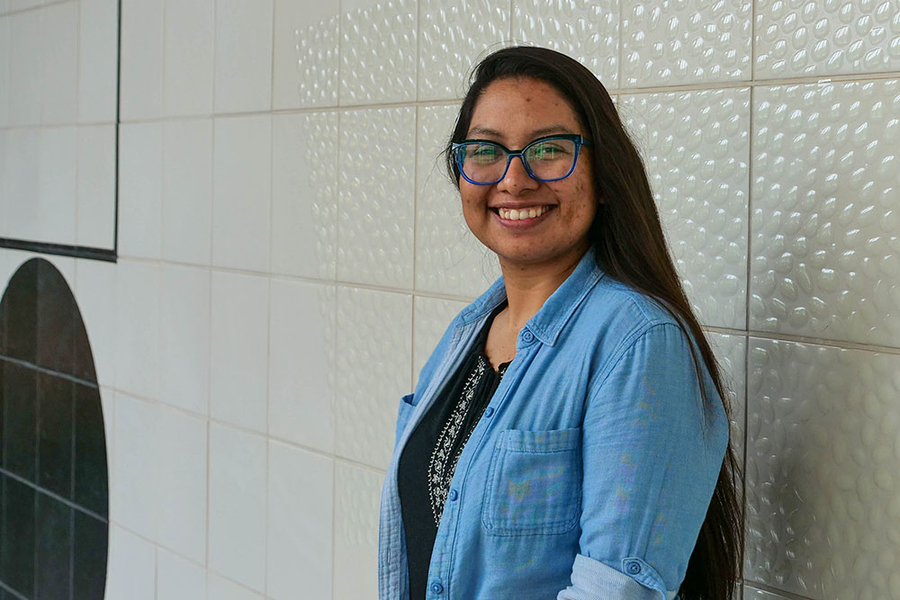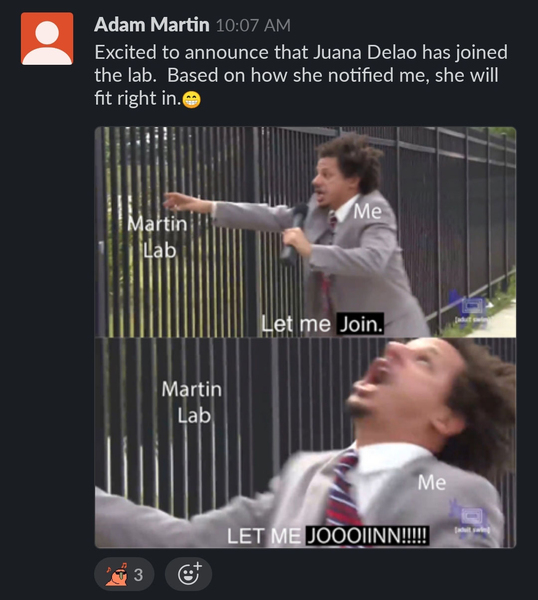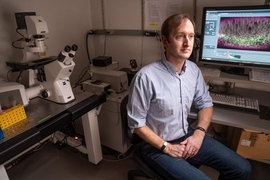MIT graduate student Juana De La O describes herself as a food-motivated organism, so it’s no surprise that she reaches for food and baking analogies when she’s discussing her thesis work in the lab of undergraduate officer and professor of biology Adam Martin.
Consider the formative stages of a croissant, she offers, occasionally providing homemade croissants to accompany the presentation: When one is forming the puff pastry, the dough is folded over the butter again and again. Tissues in a developing mouse embryo must similarly fold and bend, creating layers and structures that become the spine, head, and organs — but these tissues have no hands to induce those formative movements.
De La O is studying neural tube closure, the formation of the structure that becomes the spinal cord and the brain. Disorders like anencephaly and craniorachischisis occur when the head region fails to close in a developing fetus. It’s a heartbreaking defect, De La O says, because it’s 100 percent lethal — but the fetus fully develops otherwise.
“Your entire central nervous system hinges on this one event happening successfully,” she says. “On the fundamental level, we have a very limited understanding of the mechanisms required for neural closure to happen at all, much less an understanding of what goes wrong that leads to those defects.”
Hypothetically speaking
De La O hails from Chicago, where she received an undergraduate degree from the University of Chicago and worked in the lab of Ilaria Rebay. De La O’s sister was the first person in her family to go to and graduate from college — De La O, in turn, is the first person in her family to pursue a PhD.
From her first time visiting campus, De La O could see MIT would provide a thrilling environment in which to study.
“MIT was one of the few places where the students weren’t constantly complaining about how hard their life was,” she says. “At lunch with prospective students, they’d be talking to each other and then just organically slip into conversations about science.”
The department emails acceptance letters and sends a physical copy via snail mail. De La O’s letter included a handwritten note from department head Amy Keating, then a graduate officer, who had interviewed De La O during her campus visit.
“That’s what really sold it for me,” she recalls. “I went to my PI [principal investigator]’s office and said, ‘I have new data’” and I showed her the letter, and there was lots of unintelligible crying.”
To prepare her for graduate school, her parents, both immigrants from Mexico, spent the summer teaching De La O to make all her favorite dishes because “comfort food feels like home.”
When she reached MIT, however, the Covid-19 pandemic ground the world to a halt and severely limited what students could experience during rotations. Far from home and living alone, De La O taught herself to bake, creating the confections she craved but couldn’t leave her apartment to purchase. De La O didn’t get to work as extensively as she would have liked during her rotation in the Martin lab.
Martin had recently returned from a sabbatical that was spent learning a new research model; historically a fly lab, Martin was planning to delve into mouse research.
“My final presentation was, ‘Here’s a hypothetical project I would hypothetically do if I were hypothetically going to work with mice in a fly lab,’” De La O says.
Martin recalls being impressed. De La O is skilled at talking about science in an earnest and engaging way, and she dug deep into the literature and identified points Martin hadn’t considered.
“This is a level of independence that I look for in a student because it is important to the science to have someone who is contributing their ideas and independent reading and research to a project,” Martin says.
After agreeing to join the lab — news she shared with Martin via a meme — she got to work.
Charting mouse development
The neural tube forms from a flat sheet whose sides rise and meet to create a hollow cylinder. De La O has observed patterns of actin and myosin changing in space and time as the embryo develops. Actin and myosin are fibrous proteins that provide structure in eukaryotic cells. They are responsible for some cell movement, like muscle contraction or cell division. Fibers of actin and myosin can also connect across cells, forming vast networks that coordinate the movements of whole tissues. By looking at the structure of these networks, researchers can make predictions about how force is affecting those tissues.
De La O has found indications of a difference in the tension across the tissue during the critical stages of neural tube closure, which contributes to the tissue’s ability to fold and form a tube. They are not the first research group to propose this, she notes, but they’re suggesting that the patterns of tension are not uniform during a single stage of development.
“My project, on a really fundamental level, is an atlas for a really early stage of mouse development for actin and myosin,” De La O says. “This dataset doesn’t exist in the field yet.”
However, De La O has been performing analyses exclusively in fixed samples, so she may be quantifying phenomena that are not actually how tissues behave. To determine whether that’s the case, De La O plans to analyze live samples.
The idea is that if one could carefully cut tissue and observe how quickly it recoils, like slicing through a taught rubber band, those measurements could be used to approximate force across the tissue. However, the techniques required are still being developed, and the greater Boston area currently lacks the equipment and expertise needed to attempt those experiments.
A big part of her work in the lab has been figuring out how to collect and analyze relevant data. This research has already taken her far and wide, both literally and virtually.
“We’ve found that people have been very generous with their time and expertise,” De La O says. “One of the benefits we, as fly people, brought into this field is we don’t know anything — so we’re going to question everything.”
De La O traveled to the University of Virginia to learn live imaging techniques from associate professor of cell biology Ann Sutherland, and she’s also been in contact with Gabriel Galea at University College London, where Martin and De La O are considering a visit for further training.
“There are a lot of reasons why these experiments could go wrong, and one of them is that I’m not trained yet,” she says. “Once you know how to do things on an optimal setup, you can figure out how to make it work on a less-optimal setup.”
Collaboration and community
De La O has now expanded her cooking repertoire far beyond her family’s recipes and shares her new creations when she visits home. At MIT, she hosts dinner parties, including one where everything from the savory appetizers to the sweet desserts contained honey, thanks to an Independent Activities Period course about the producers of the sticky substance, and she made and tried apple pie for the first time with her fellow graduate students after an afternoon of apple picking.
De La O says she’s still learning how to say no to taking on additional work outside of her regular obligations as a PhD student; she’s found there’s a lot of pressure for underrepresented students to be at the forefront of diversity efforts, and although she finds that work extremely fulfilling, she can, and has, stretched herself too thin in the past.
“Every time I see an application that asks ‘How will you work to increase diversity,’ my strongest instinct is just to write ‘I’m brown and around — you’re welcome,’” she jokes. “The greatest amount of diversity work I will do is to get where I’m going. Me achieving my goals increases diversity inherently, but I also want to do well because I know if I do, I will make everything better for people coming after me.”
De La O is confident her path will be in academia, and troubleshooting, building up protocols, and setting up standards for her work in the Martin Lab has been “an excellent part of my training program.”
De La O and Martin embarked on a new project in a new model for the lab for De La O’s thesis, so much of her graduate studies will be spent laying the groundwork for future research.
“I hope her travels open Juana’s eyes to science being a larger community and to teach her about how to lead a collaboration,” Martin says. “Overall, I think this project is excellent for a student with aspirations to be a PI. I benefited from extremely open-ended projects as a student and see, in retrospect, how they prepared me for my work today.”









